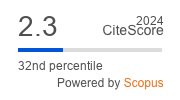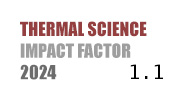ABSTRACT
Heat flux in electronic devices has increased dramatically with the development of advanced IC technology, facing the demand for effective thermal management technology. Micro pin-fin heat sink (MPFHS) has been demonstrated to be capable of improving the heat transfer capability and suppressing temperature rise effectively. In order to elaborate the discrepancy of heat dissipation of the MPFHS due to the cross-section shapes of pin-fin structures a set of heat sink samples with four different shapes, including the circle-MPFHS, the square-MPFHS, the crisscross- MPFHS, and the octagon-MPFHS, are fabricated with micromachining technology. Then, the thermal characteristics are tested by integrating the heat sinks with a Pt film resistor chip as the heating source, and nucleate boiling phenomenon was observed with a high-speed camera. Results showed that concave corners in pin-fin structures increased the specific surface area, but generated low velocity vortexes in back flow regions, reducing the heat transfer capability. The heat transfer coefficients of the octagon-MPFHS, the crisscross-MPFHS, and the circle- MPFHS was increased by 161.9 %, 152.4%, and 85.7 %, respectively, relative to the square-MPFHS at the flow rate of 147 kg/m2s. The heat transfer coefficients of the octagon-MPFHS, the crisscross-MPFHS, the circle-MPFHS, and the square- MPFHS was increased by 7.27%, 11.32%, 2.56%, and 4.76% when the mass-flow rate was increased from 147 kg/m2s to 295 kg/m2s. The nucleate boiling phenome-non in the crisscross-MPFHS showed periodicity and positive feedback effect, resulting in local dry-out and consequent heat transfer capability deterioration. This study will contribute to the design and modification of MPFHS.
KEYWORDS
PAPER SUBMITTED: 2023-03-11
PAPER REVISED: 2023-07-04
PAPER ACCEPTED: 2023-07-12
PUBLISHED ONLINE: 2023-09-02
THERMAL SCIENCE YEAR
2024, VOLUME
28, ISSUE
Issue 2, PAGES [889 - 901]
- Bailey, C., Thermal Management Technologies for Electronic Packaging: Current Capabilities and Future Challenges for Modelling Tools, Proceedings, 10th Electronics Packaging Technology Conference, Sin-gapore, 2008, pp. 527-532
- Nadjahi, C., et al., A Review of Thermal Management and Innovative Cooling Strategies for Data Center, Sustainable Computing: Informatics and Systems, 19, (2018), Sept., pp. 14-28
- Tuckerman, D. B., Pease, R. F. W., High-Performance Heat Sinking for VLSI, IEEE Electron Device Letters, 2 (1981), 5, pp. 126-129
- Ali, A. M., et al., Numerical Analysis on the Thermal Performance of Microchannel Heat Sinks with Al2O3 Nanofluid and Various Fins, Applied Thermal Engineering, 198 (2021), 117458
- Shi, X., et al., Geometry Parameters Optimization for a Microchannel Heat Sink with Secondary Flow Channel, International Communications in Heat and Mass Transfer, 104 (2019), May, pp. 89-100
- Sabzpoushan, S., Sabouri, M., Secondary Flow Through Lateral Passages to Improve Hydrothermal Per-formance of Liquid-Cooled Microchannel Heat Sinks, Applied Thermal Engineering, 227 (2023), 120009
- He, W., et al., Hydrothermal Performance of Nanofluid Flow in a Sinusoidal Double Layer Microchannel in Order to Geometric Optimization, International Communications in Heat and Mass Transfer, 117, (2020), 104700
- Derakhshanpour, K., et al., Improving Performance of Single and Double-Layered Microchannel Heat Sinks by Cylindrical Ribs: A Numerical Investigation of Geometric Parameters, International Communi-cations in Heat and Mass Transfer, 126 (2021), 105440
- Maheswari, A., Prajapati, Y. K., Thermal Performance Enhancement and Optimization of Double-Layer Microchannel Heat Sink with Intermediate Perforated Rectangular Fins, International Journal of Thermal Sciences, 185 (2023), 108043
- Shen, H., et al., Thermofluids Performances on Innovative Design with Multi-Circuit Nested Loop Appli-cable for Double-Layer Microchannel Heat Sinks, Applied Thermal Engineering, 219 (2023), 119699
- Ma, C., et al., A Bio-Inspired Fractal Microchannel Heat Sink with Secondary Modified Structure and Sub-Total-Sub Fluid Transmission Mode for High Heat Flux and Energy-Saving Heat Dissipation, Inter-national Journal of Heat and Mass Transfer, 202 (2023), 123717
- Li, H., et al., Effects of Inclination Angle and Heat Power on Heat Transfer Behavior of Flat Heat Pipe with Bionic Grading Microchannels, Applied Thermal Engineering, 206 (2022), 118079
- Huang, P., et al., Numerical Investigation of the Fluid Flow and Heat Transfer Characteristics of Tree- Shaped Microchannel Heat Sink with Variable Cross-Section, Chemical Engineering and Processing - Process Intensification, 147 (2020), 107769
- Peng, H., et al., Thermal Management of High Concentrator Photovoltaic System Using a Novel Double- Layer Tree-Shaped Fractal Microchannel Heat Sink, Renewable Energy, 204 (2023), Mar., pp. 77-93
- John Peter, R., et al., Comparative Study on the Thermal Performance of Microencapsulated Phase Change Material Slurry in Tortuous Geometry Microchannel Heat Sink, Applied Therm. Eng., 218 (2023), 119328
- Rajabi Far, B., et al., Effects of Pin Tip-Clearance on the Performance of an Enhanced Microchannel Heat Sink with Oblique Fins and Phase Change Material Slurry, International Journal of Heat and Mass Trans-fer, 83 (2015), Apr., pp. 136-145
- Chen, M., et al., Experimental Study on Micro-Encapsulated Phase Change Material Slurry Flowing in Straight and Wavy Microchannels, Applied Thermal Engineering, 190 (2021), 116841
- Shahsavar, A., et al., Experimental Study of a Nanofluid-Based Photovoltaic/Thermal Collector Equipped with a Grooved Helical Microchannel Heat Sink, Applied Thermal Engineering, 217 (2022), 119281
- Rostami, S., et al., Numerical Assessment of the Multi-Phase Nanofluid Flow Inside a Microchannel Dur-ing the Melting and Solidification of PCM in the Thermal Management of a Heatsink, Engineering Anal-ysis with Boundary Elements, 148 (2023), Mar., pp. 267-278
- Huang, Y., et al., Thermophysical Property Evaluation of β-Cyclodextrin Modified ZrO2 Nanofluids for Microchannel Heat Exchange, Ceramics International, 48 (2022), 21, pp. 31728-31737
- Li, W., et al., Enhanced Flow Boiling in Microchannels Integrated with Supercapillary Pinfin Fences, International Journal of Heat and Mass Transfer, 183 (2022), 122185
- Lin, Y., et al., Enhancement of Flow Boiling Heat Transfer in Microchannel Using Micro-Fin and Micro-Cavity Surfaces, International Journal of Heat and Mass Transfer, 179 (2021), 121739
- Li, Y., Wu, H., Experiment Investigation on Flow Boiling Heat Transfer in a Bidirectional Counter-Flow Microchannel Heat Sink, International Journal of Heat and Mass Transfer, 187 (2022), 122500
- Lie, Y. M., et al., Saturated Flow Boiling Heat Transfer and Associated Bubble Characteristics of FC-72 on a Heated Micro-Pin-Finned Silicon Chip, International Journal of Heat and Mass Transfer, 50 (2007), 19-20, pp. 3862-3876
- Woodcock, C., et al., Ultra-High Heat Flux Dissipation with Piranha Pin Fins, International Journal of Heat and Mass Transfer, 128 (2019), Jan., pp. 504-515
- Lorenzini, D., et al., Embedded Single Phase Microfluidic Thermal Management for Non-Uniform Heat-ing and Hotspots Using Microgaps with Variable Pin Fin Clustering, International Journal of Heat and Mass Transfer, 103 (2016), Dec., pp. 1359-1370
- Heo, K. Y., et al., Fabrication and Experiment of Micro-Pin-Finned Microchannels to Study Surface Roughness Effects on Convective Heat Transfer, J. Micromech. Microeng., 24 (2014), 12, 125025
- Chen, B., et al., Flooded Two-Phase Flow Dynamics and Heat Transfer With Engineered Wettability on Microstructured Surfaces, Journal of Heat Transfer, 137 (2015), 9, 091021

